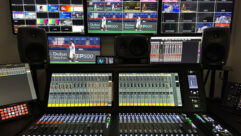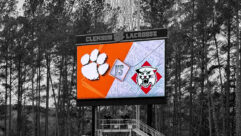In this edition of the SVC Podcast, SVC Contributing Editor Bennett Liles continues his talk with Clinton Wimberly of Inter Technologies Corporation (ITC) about its installation of a facility-wide sound system that includes18 Biamp AudiaFLEX units in the France A. Cordova Recreational Sports Center at Purdue University. Clinton explains how the automatic ambient noise compensation function works and discusses the Crestron control for the system.
Links of interest:
- Inter Technologies Corporation (ITC) with offices in seven states
- The Biamp AudiaFLEX digital audio platform
- Crestron TPMC V15 15-inch touch panel
- Crestron MC2E processor for central system control
- Crestron CNX-B button pads for local control
Download Podcast Here:
https://s3.amazonaws.com/nb-svc/public/public/8_21_14-ITC-Purdue_Clinton…
Editor’s note: For your convenience, this transcription of the podcast includes timestamps. If you are listening to the podcast and reading its accompanying transcription, you can use the timestamps to jump to any part of the audio podcast by simply dragging the slider on the podcast to the time indicated in the transcription.
The France A Córdova Recreational Sports Center at Purdue University needed a massive sound system installation and ITC came in with 18 AudiaFLEX units and Crestron control. Clinton Wimberly was onsite and he’s back to finish up his story about how it all went in and worked. Next up on the SVC Podcast.
Clinton, thanks for being back with us for part two on the SVC Podcast and we’re talking about the massive Biamp AudiaFLEX system installed by ITC in the newly renovated France A Córdova Recreational Sports Center at Purdue University. We talked about the cable pulling when you got in there but we didn’t talk about the control part of this system so how does the control for all of these different AudiaFLEX units work?
Thanks for having me back, Bennett. The main control for all these AudiaFLEXes was done with a 15-inch Crestron touch panel which was stationed at the reception desk on the center floor and the touch panel has full control of all the different zones for level and on and off, and this is also where they can turn on and off all the paging using the microphone at the desk to make announcements across the rec center, inside and outside. And beyond the AudiaFLEX it also has control of all the displays. We have over 70 displays throughout that building, and that’s not including the four-by-four video wall that we’ve installed there. But in regards to the AudiaFLEX, it has a main control at the reception desk done with a 15-inch Crestron touch panel but there’s also, in all the different spaces from the basement floor to the 4th floor, there’s Crestron button pads in all the gym spaces and pad spaces on the floor where they can control the house music and any local sources that they had in that space. [Timestamp: 2:14]
Okay, so they can bring in their own source devices, plug them right in and play them in their own space.
Right. They can bring their iPod or what have you. There’s also several mobile audio carts that we installed for them that they wheel around to the different spaces as well.
In a place that big, it could get pretty noisy. How does the automatic ambient noise compensation system work?
Oh, the ambient noise? Well, there were microphones placed strategically around the rec center on the ceilings for the most part and the Biamp takes the noise level of the microphone in and adjusts the output level to that area. And what happens is this ensures that even if, for instance, you’re in the gym and a basketball game’s going on, announcements can still be heard. With the way we did our rigorous tests and setting all the gains and gates and clips so that any time, in any environment, the announcements can be heard across the building. [Timestamp: 3:09]
Yeah, that would save a lot of time and trouble because in that place it could be almost a full time job just turning the sound level up and down all the time.
Yeah, absolutely.
We talked a little about this in part one, but the main thing you had to do when you got in there was just pulling a whole lot of wire.
That was a chore. Yes, the wire pulling was a very large portion of the job. The building was well prepared with conduit and wire trays in different locations as we talked about before. The size of the job presented problems with wire pulling because we had to go very long distances as well as a large height above the finished floor to get the wires where they needed to go. Typically we used shielded, twisted pairs but there’s also a lot of fiber networks and even some coax RG-6 for all the TV displays that we put out there. [Timestamp: 3:56]
And you had to install all of this in stages so how did the testing go? Was it just ringing out the wiring and then connecting various sources to see how they sounded?
Well there was a lot of phases of testing as you can probably assume with the massive size of the building. In a nutshell, testing went pretty well being that that was the case. It took many people and two-way radios so that adjustment could be made from the AV closet while people walked the building with meters so that the levels could be set. But it was definitely a rigorous process that took a lot of time and a lot of leg work to get everything right, but all in all testing went pretty well. [Timestamp: 4:34]
One of the frequent things that happens with any new system, even if it all technically works right, is user error. So did ITC provide some kind of training program on this and how did the users take to it?
Yes, ITC did provide training and users took to it very well throughout the process of design. Purdue was involved in helping choose the features that they thought they wanted or needed and Inter Tech always kept in mind the different people that would be using the panel all the time, so it needed to be a very intuitive interface and use many one-button features to make it simple for the end users. [Timestamp: 5:07]
Yeah, once they see it work and what it can do they start dreaming up other things they’d like to do with it; which could be good or kind of a pain, too.
Yeah. Yeah, some days absolutely. I mean they have a lot of the students working there and students are only there for typically four years max and people are cycling through. So we have to train the trainer, so to speak, for a lot of the administrative staff that work there so they can teach the coming and going students to work the desk with this 15-inch Crestron touch panel. And then all of the spaces where they have a button pad there’s typically, say, a dance instructor who’s for instance running a Zumba class and she’d have her team so we train her and then she’d train her peers and it worked that way across the building in all the different spaces. I mean they had wrestling rooms and fencing rooms and all of these spaces were tied into the AudiaFlex somehow someway. [Timestamp: 6:06]
It’s so good when you see it all work and the users get excited about what they can do with it. Now you’ve got this one done so what’s coming up next for ITC?
We’ll continue to focus on providing high quality AVC services to a large range of clients as we expand into multiple states, and in particular we do have some large jobs coming up. We just landed some pretty substantial contracts with Amazon. We just brought them on as a client, so we’ll be doing a lot of their facilities. Some more of the North Carolina schools; I think UNC signed on so we’ll be exclusively doing work there. And we’re just looking to expand and try and cover and a nice footprint in this country of ours. [Timestamp: 6:51]
The France A. Cordova Recreational Sports Center at Purdue University, a big job and it was a very interesting project. Clinton Wimberly of ITC was there and Clinton, it was great having you tell us about it.
It was a pleasure, Bennett. Thanks for talking to me.
Thank you for being with us for the SVC Podcast with Clinton Wimberly of ITC. Show notes are available on the web site ofSound & Video Contractor Magazineatsvconline.com. Be with us again for the next SVC Podcast.










